| Advertisement |  |
Click to advertise with us! |
You are using an out of date browser. It may not display this or other websites correctly.
You should upgrade or use an alternative browser.
You should upgrade or use an alternative browser.
Prettiest Sax of the Moment
- Thread starter pete
- Start date
Pretty Package
In the spirit of a proud parent (who [nearly] always believe their latest offspring is the prettiest thing on the planet), I have a new arrival.
And I think it is so pretty, I feel the need to share...
Not only is it pretty, it really is the complete package.
Couesnon Monopole II sopranos are hard to come by. They are great players (of course I am biased) and rarely come up on Ebay. I have just received one in the most amazing condition
AND it is keyed to top F# - which is something I have never seen in a soprano before.
Complete with mouthpiece, original lyre, guarantee, keys for the case - even a box of Selmer Soloist reeds
Take a look....
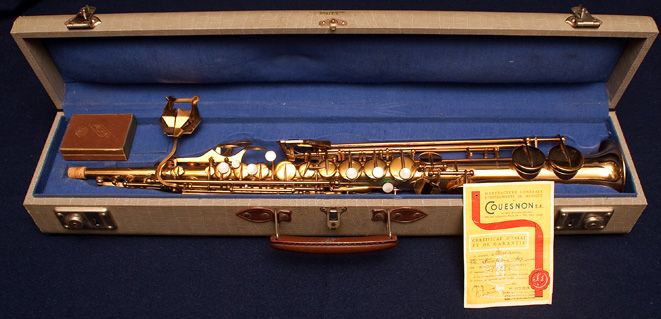

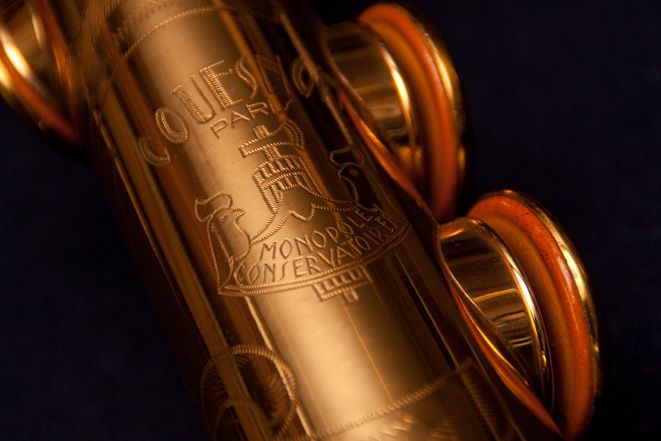
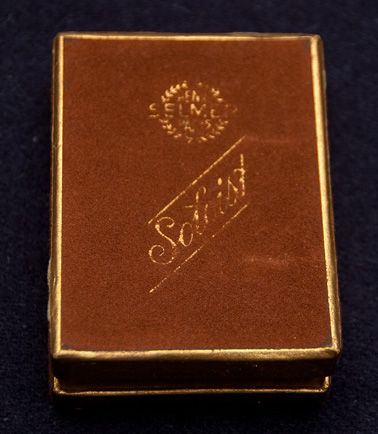
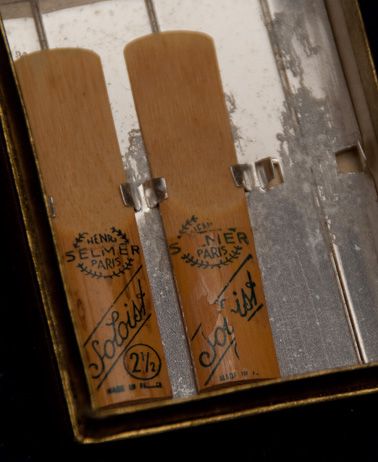
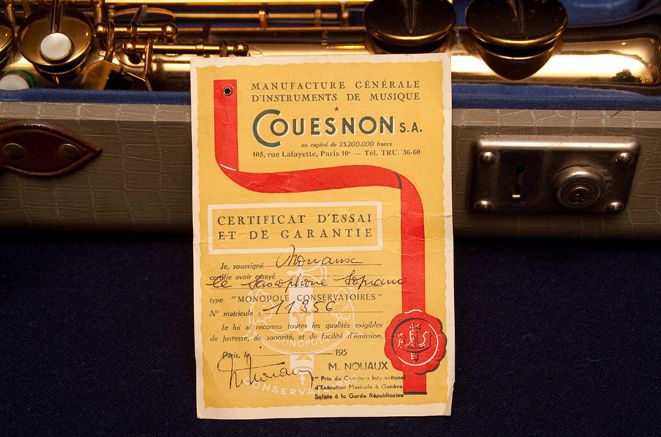
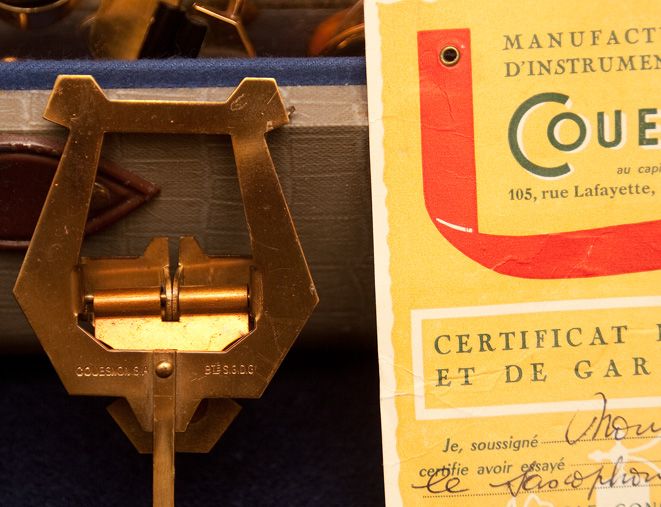

Proud Parent
In the spirit of a proud parent (who [nearly] always believe their latest offspring is the prettiest thing on the planet), I have a new arrival.
And I think it is so pretty, I feel the need to share...
Not only is it pretty, it really is the complete package.
Couesnon Monopole II sopranos are hard to come by. They are great players (of course I am biased) and rarely come up on Ebay. I have just received one in the most amazing condition
AND it is keyed to top F# - which is something I have never seen in a soprano before.
Complete with mouthpiece, original lyre, guarantee, keys for the case - even a box of Selmer Soloist reeds
Take a look....








Proud Parent
That's one super find!
I was cruising eBay.ch tonight. I found two interesting horns.
The first is this Weltklang alto. While the horn is not terribly rare, the finish has aged beautifully. People now pay extra to get horns that look like this.
The second horn is more striking than beautiful. It's an Akustik from VEB (see Helen's galleries of VEB stuff). It's striking because the "pearl" inlay is RED. I do think it's original: I've seen many horns with the "screw on" pearls and I've seen many other horns with various colored stones or glass in place of the pearls.
The first is this Weltklang alto. While the horn is not terribly rare, the finish has aged beautifully. People now pay extra to get horns that look like this.
The second horn is more striking than beautiful. It's an Akustik from VEB (see Helen's galleries of VEB stuff). It's striking because the "pearl" inlay is RED. I do think it's original: I've seen many horns with the "screw on" pearls and I've seen many other horns with various colored stones or glass in place of the pearls.
Maybe the Akustik stuff would be better in a dedicated thread.
Just a word on VEB - it's a german acronym for Volkseigener Betrieb literally translated as people's enterprise - or better as nationally owned enterprise. And the research today reminded me I'd been using the term wrongly.
In East German times, there were many VEBs, and Weltklang were made by the 'VEB Blechblas- und Signal-Instrumenten-Fabrik', later to be known as B&S, while the Akustiks were made by a post war VEB, 'VEB Sächsische Musikinstrumentenfabrik Klingenthal' that was the successor to the Ernst Hess (Heß) instrument makers. This, along with other VEBs became merged into the 'VEB Blechblas- und Signal-Instrumenten-Fabrik'.
Just a word on VEB - it's a german acronym for Volkseigener Betrieb literally translated as people's enterprise - or better as nationally owned enterprise. And the research today reminded me I'd been using the term wrongly.
In East German times, there were many VEBs, and Weltklang were made by the 'VEB Blechblas- und Signal-Instrumenten-Fabrik', later to be known as B&S, while the Akustiks were made by a post war VEB, 'VEB Sächsische Musikinstrumentenfabrik Klingenthal' that was the successor to the Ernst Hess (Heß) instrument makers. This, along with other VEBs became merged into the 'VEB Blechblas- und Signal-Instrumenten-Fabrik'.
Your demand is my wish ... or something like that. Continued discussion on Akustik at http://woodwindforum.com/forums/showthread.php?t=4260.
Julius Keilwerth King Modell Lus.
There are two variants of this model. I had only seen the first.
Anyhow, this model with the lots of loops for keyguards is for sale through here for 1150 Euros. There are quite a few uncommon horns on that website ....
There are two variants of this model. I had only seen the first.
Anyhow, this model with the lots of loops for keyguards is for sale through here for 1150 Euros. There are quite a few uncommon horns on that website ....
Julius Keilwerth King Modell Lus.
There are two variants of this model. I had only seen the first.
Anyhow, this model with the lots of loops for keyguards is for sale through here for 1150 Euros. There are quite a few uncommon horns on that website ....
There's an alto for sale here (no loops): http://www.ebay.de/itm/280896009750?ssPageName=STRK:MEWAX:IT&_trksid=p3984.m1423.l2649
Failed to sell last week at the same prices he's asking this week.
Didn't realise these were rare. Amati made? (That's a qustion, not a suggestion).
If Amati was involved in any way, it'd be more accurate to say, "Amati assembled." These horns do have the standard, "Best in the World," stamp on them and the G#'s engraved, "Keilwerth," so that heavily implies that there was no outside involvement. Remember that Amati wasn't shy about keeping their name off of Tonekings.
Dating could be easy if I had found one of these with an actual serial number. Without one, I'd have to decide between a few things:
* Is a Keilwerth "King" model an "entry level" horn made with an older design, with the New King and Toneking being higher models made with a newer design?
* Did the "King" models disappear around s/n 13000 or are there newer ones?
* Does the wire key guard automagically = old? I've seen a lot of Germanic horns in the past few days and I think that it can be argued that wire key guards do not = old, but anywhere from 1900ish to 1960.
I'm still playing around with Germanic instruments, but I do *think* I can make a very good argument that there were only a couple companies that produced new designs, kinda like Conn, Buescher, Martin and others in the US did with stencils. It's harder than with US horns because you've got the *possibility* that the keywork was customized.
Research will continue.
Dating could be easy if I had found one of these with an actual serial number. Without one, I'd have to decide between a few things:
* Is a Keilwerth "King" model an "entry level" horn made with an older design, with the New King and Toneking being higher models made with a newer design?
* Did the "King" models disappear around s/n 13000 or are there newer ones?
* Does the wire key guard automagically = old? I've seen a lot of Germanic horns in the past few days and I think that it can be argued that wire key guards do not = old, but anywhere from 1900ish to 1960.
I'm still playing around with Germanic instruments, but I do *think* I can make a very good argument that there were only a couple companies that produced new designs, kinda like Conn, Buescher, Martin and others in the US did with stencils. It's harder than with US horns because you've got the *possibility* that the keywork was customized.
Research will continue.
I don't think any saxophone was ever designed to play badly. I've already remarked about seeing Bundy II saxes that played well.
I just finished repadding one of the dreaded "Shooting Star" Conns, but this one was an early model, made in Elkhart circa 1965. The intonation was terrific, and the tone wasn't bad either. The horn had been assembled by workers who had decades of experience, and it showed.
I just finished repadding one of the dreaded "Shooting Star" Conns, but this one was an early model, made in Elkhart circa 1965. The intonation was terrific, and the tone wasn't bad either. The horn had been assembled by workers who had decades of experience, and it showed.
Andrieu Freres Standarluxe.
As you can see from how I've classified this horn, it's quite probably a Raymond Dubois Universel stencil: you can start comparing features like the socket receiver and the address.
Pity it doesn't have the extra billion keys like other Essors,
As you can see from how I've classified this horn, it's quite probably a Raymond Dubois Universel stencil: you can start comparing features like the socket receiver and the address.
Pity it doesn't have the extra billion keys like other Essors,
What about this one?
http://www.ebay.de/itm/Altes-Saxoph...t=Antike_Musikinstrumente&hash=item4d02577a78
And no, I didn't post it to get another stencil discussion going.... Don't agree the Seller's dating, though - more like 50s or 60s.
http://www.ebay.de/itm/Altes-Saxoph...t=Antike_Musikinstrumente&hash=item4d02577a78
And no, I didn't post it to get another stencil discussion going.... Don't agree the Seller's dating, though - more like 50s or 60s.
First, I've played a few Bundy IIs that did play pretty well. Sometimes I do enjoy making a joke out of the ingrained idea that Bundys suck, but I've mentioned one of their biggest strengths is that you can subject 'em to a lot of damage and they still play pretty OK.I don't think any saxophone was ever designed to play badly. I've already remarked about seeing Bundy II saxes that played well.
Second, I don't necessarily think someone designed a particular horn to be bad, but how the design was implemented makes the horn bad. As an example, take a decent horn design. Take a few quick measurements -- you're on a schedule, you know, so don't double check. Use the cheapest possible materials. Some of those details that look expensive or difficult to implement, g'head and axe those. Finally, have unskilled labor that makes $1 a year fabricate and assemble the horn. So, you've just gone from an SML Gold Medal (a pro horn that was designed extremely well) to a Heimer (which is an Asian copy of the Gold Medal).
I also believe that the reverse is true: no matter how good the materials you're using in fabricating the instrument, if the horn just has a bad design, it's going to be a bad horn. I think this is extremely rare, though. You might be able to argue this about the Grafton: made with the best stuff available at the time, but it's got an odd feel to it and they're not durable. (Of course, you also have to remember that the Grafton was never intended as a pro instrument.)
As far as the Triumpf goes, it looks an awful lot like an early JK. (Before they moved their chromatic F# key to the side from the back.) So yes, maybe it could be late 1930s, or more likely 1940s. Since we don't see the right thumb rest area, we can't see if it has a Best In the World or JK engraving, but if I had to hazard a guess, I'd go with JK. The right pinkie key shapes and the shape of the spacer at the top of the octave key lever, where it connects to the next rod (where Selmer had their legendary Cigar Cutter circle), these are just 2 of the things that make me think JK. (Although you didn't want to get into another stencil discussion. I did anyway.... Sorry...) 
As far as prettiness goes, yes, these early JKs were among the prettiest of their horns. IMHO of course...
As far as prettiness goes, yes, these early JKs were among the prettiest of their horns. IMHO of course...
OK, I'm about 7 years late to the party, but I think the B&S Chicago horns look fantastic. I'll see if I can find one in silver plate.
OK, I'm about 7 years late to the party, but I think the B&S Chicago horns look fantastic. I'll see if I can find one in silver plate.
Me too!
